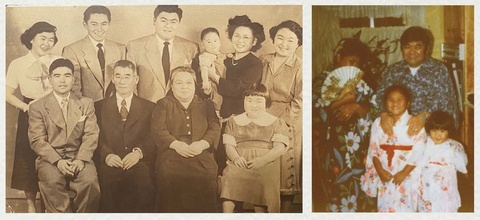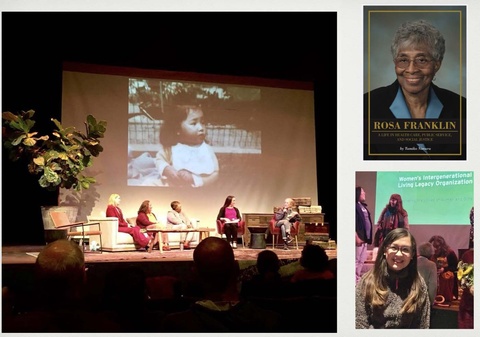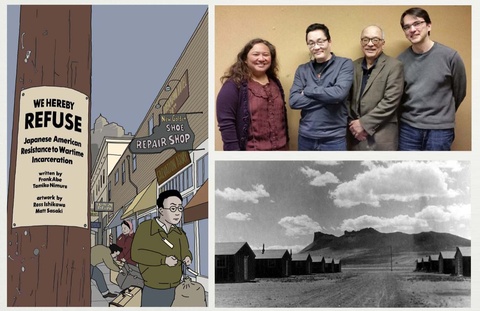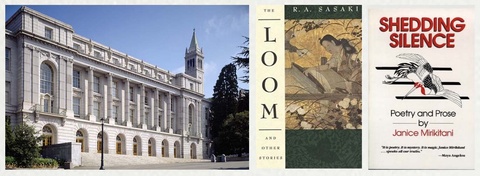The following essay is adapted from a talk that I gave to the City of Tacoma Historic Preservation, Tacoma Historical Society, and Historic Tacoma in November 2020. An edited video version is available here on YouTube.
I’ve been asked to talk about my work documenting Tacoma’s Japanese American and African American history. It’s been a great privilege—and a little surprising—for me to be doing this work, which is why I called the talk “Falling Into Public History.”
* * * * *
Image 1: My roots

When I talk about my writing I have to start with my roots, and so these are images I think about a lot. This is two family snapshots. One represents my Japanese American extended family: my Issei grandparents (seated in the middle) and their parents, and their first grandchild, my cousin Eddie. My dad’s the young man standing in the middle. The other picture is my immediate family, my Filipina American mom and my Nisei dad, and me and my sister. We’re all in yukata, given to us on our first trip to Japan.
Growing up in a cross-cultural existence, Japanese American and Filipina American, was not always easy. I’ve written about this growing up elsewhere. But one thing I took from both sides of my heritage was the importance of gathering—for holidays, for New Year’s and Christmas and Easter. From my Japanese American extended family, which used to reunite every year for Oshogatsu, I inherited the importance of roots, and deep history. So much of this history included the history of Japanese American wartime incarceration.
Image 2: Where literature and history meet
As a librarian’s daughter, I grew up surrounded by books, and in some ways it seemed an easy choice to become an English major in college. I arrived at UC Berkeley just as the universitywide American Cultures requirement had been passed, and was drawn to literature classes by and about people of color in the United States. Wheeler Hall, on the left, is the home of the English department. I chose to write about Sansei women writers (Janice Mirikitani and R.A. Sasaki) for my honors thesis, and was stunned when my advisor told me that not everyone would let me include historical context in the project.
There were a few things that I took away from that conversation. This was one of the most intimate encounters I’d had with the power of stories—that is, the stories that are suppressed. I was outraged that my beloved discipline of English could be so hostile to the history which made my project on Nisei silence and memory more legible. I learned about the archives: where they were more populated, where they were more segregated, and where they were silent. I also became interested in historiography, or the power dynamics in writing history. In the words of Lin-Manuel Miranda’s musical Hamilton, “Who lives, who dies, who tells your story?”
I went on to graduate school and got my Master’s and PhD in English. But I also had training in American ethnic studies, studying the issues that crossed and separated communities of color by studying their histories and literatures. I knew that I needed a foundation to study race in the United States, and had training in African American literature and culture.
Image 3: Community journalism
After a “bad breakup” with academia, I began to build a portfolio with work in community journalism. I wrote book reviews, arts writing, and began event previews and profiles of Asian American artists for Seattle’s International Examiner. One of my first articles for Discover Nikkei was an article about Ichiro and his departure from the Seattle Mariners for the New York Yankees. Not long after that, the editors of Discover Nikkei asked me to write a commissioned series of essays, which has been ongoing for 8 years. My editors at these outlets trained me on the job with some unwritten but firm rules: Go out into the community. Meet people, build relationships, document their stories.
Image 4: Tacoma’s Japantown map, Tacoma language school memorial

While writing about Japanese American people, places, and events, I met writer Justin Wadland, who is librarian at the University of Washington, Tacoma. Justin invited me to write for HistoryLink, the Washington State online encyclopedia. From HistoryLink meetings I met local historian and historic preservation Michael Sullivan. I dove into learning about Tacoma’s historic Japantown; I learned about how much Tacoma lost due to the country’s mass incarceration; I learned about the city’s Japanese language school; I learned how a map could break your heart. The history writing led to Days of Remembrance for Tacoma, and walking tours of our historic Japantown. Michael and I dove into the lesser-known histories of buildings like the Lorenz Hotel, and Justin and I co-wrote a short history of the Tacoma Buddhist Temple. I collaborated with Yonsei writer Vince Schleitwiler on a history of Japanese American farms and farming on Vashon Island. I learned and wrote about Dr. George Tanbara and his wife Kimi, and their partnership which sustained much of Tacoma’s Japanese American community and created health care clinics for low-income and communities of color.
Image 6 and 7: My first two books

My work on the Tanbara’s became especially important in understanding the story of Tacoma’s Rosa Franklin, who was the second African American woman to be elected to that office in our state’s history. Senator Franklin’s distinguished 42-year career in health care across a spectrum of communities was followed by her 20-year career in the Washington State legislature. I conducted her oral history and wrote her biography. I learned so much about Tacoma, our history, and the stories of housing and health care for different communities in our city. Doing this project was a huge gift for me—one that I’ll be unpacking for the rest of my life, if I’m being very honest.
Meanwhile, I was hired by Seattle’s Wing Luke Asian Museum in 2017 to work on a graphic novel. It’s co-written with Frank Abe, illustrated by Ross Ishikawa and Matt Sasaki. It’s called We Hereby Refuse: Japanese American Acts of Wartime Resistance, forthcoming in February 2021 from Chin Music Press and the Wing Luke Asian Museum. My work in public history has grown out of my work in community journalism, and I’m very grateful for the opportunities and training that these outlets have given me. My third book, Pilgrimage (a memoir in progress), will continue this work in history and storytelling and community and grief across generations.
Image 8: Some Things I’ve Learned

There are a few things I’ve learned by falling into public history.
First, there’s a hunger for public history that I hadn’t expected—a passion for the story, the place, the objects, the moments, made accessible (walking tours, HistoryLink).
Second, there’s a need for public history by and about people of color. We need to not only see ourselves in the history in that’s being written, we also need to be able to see ourselves as the authors of that history.
Third, historic preservation is a field that can and should interest students of American ethnic studies—whose buildings get to stay, whose stories get told and circulated, and as we grow and develop in Tacoma, what historic preservation looks like. Historic preservation might not look only like preserving older buildings, or creating plaques and monuments. I’m thinking about efforts like #DesignTheHill, organized by the arts organization Fab-5 in Tacoma’s Hilltop, involving the stories of people who have lived there. Or the Puyallup tribe, who’s been producing great videos about language, heritage, and culture.
Overall, my work in public history has taught me a great deal about how history can affect and inflect our identity. How we see ourselves now has to be a textured, sedimented, multivocal view of who we have been.
© 2020 Tamiko Nimura







